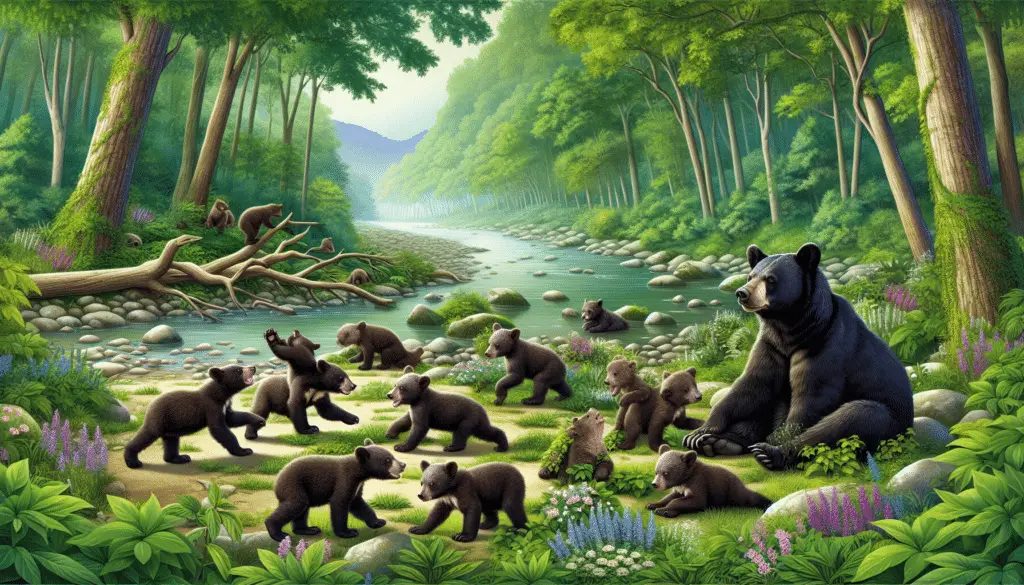TLDR;
Table of Contents
ToggleWith each litter ranging from one to three cubs, a healthy black bear in an undisturbed environment might have up to 24 cubs throughout her life.
Understanding Black Bear Reproduction and Lifespan
When we dive into the reproductive habits of black bears, there are several fascinating aspects to explore.
The average lifespan of a black bear in the wild ranges from 18 to 23 years, though captive black bears can live longer, surpassing 30 years in some instances.
To understand how many cubs a female black bear, also known as a sow, can have during her lifetime, we must first consider their age of maturity.
Black bears typically reach sexual maturity at about 3 to 5 years of age, with most females breeding for the first time at the age of 3 to 4.
Once they reach breeding age, sows enter into a reproductive cycle known as estrus annually, usually during the late spring and early summer months.
Understanding the species’ reproductive capacity is crucial not only for wildlife enthusiasts but also for those involved in bear conservation efforts.
Conservation-minded individuals might look to studies like those released by wildlife agencies that track black bear populations to understand trends and influence protective regulations.
Reproductive Rate of Black Bears
The reproductive rate of black bears is influenced by various factors including geography, food availability, and overall health.
In optimal conditions, a female black bear is capable of reproducing every other year after reaching maturity.
The gestation period for black bears is approximately 220 days; however, this includes a period of delayed implantation.
Actual embryonic development is estimated to be only about two months before the cubs are born.
On average, one to three cubs are born per litter, and it’s not uncommon for a sow to give birth to twins.
Litter Frequency and Cub Survival
A black bear sow will typically produce a litter every two to three years once she reaches breeding maturity.
This cycle allows her to care for and wean her cubs, teaching them vital survival skills before she mates again.
Many factors affect cub survival, including harsh climates, scarcity of food, and predators.
In some cases, especially in areas where natural food is less available, human intervention attempts to supplement bears’ diets.
Feeding stations, though contentious, can sometimes be found in bear habitats, with the aim of aiding their survival.
However, these stations can lead to habituation, making bears more dependent on humans and potentially leading to conflicts.
Black Bear Litter Size Variations
Litter sizes can vary greatly among black bears, influenced by the mother’s health and age, availability of mates, and regional food supplies.
In areas where there is a surplus of natural food sources, sows are more likely to have larger litters.
Additionally, older and more experienced sows may produce more cubs per litter compared to those who are younger and less experienced.
Research has shown that the age of the bear plays a significant role in litter size, with sows typically having fewer cubs as they get older.
Human Impact on Black Bear Reproduction
Human activities can have a profound impact on black bear reproduction and survival.
Habitat loss due to development, logging, and agriculture can limit the food available for bears, leading to reduced reproductive success.
Conversely, some human practices, such as regulated hunting, can be managed to maintain a balanced and sustainable bear population.
Finding ways to coexist with these animals while managing forests and wild spaces responsibly is a continuous challenge for conservationists.
If you enjoy observing wildlife and want to contribute to bear conservation, you might consider investing in responsible wildlife tours.
Companies like Wildlife Acoustics offer equipment to researchers and enthusiasts that can record and analyze animal sounds, providing valuable data without disturbing natural behavior.
Find This and More on Amazon
Total Cubs Over a Black Bear’s Lifetime
To calculate the total number of cubs a black bear can have in a lifetime, we must consider the bear’s reproductive span.
Assuming a sow begins breeding at 4 years old and continues until around 20, she potentially could rear about 5 to 8 litters in her lifetime.
With each litter ranging from one to three cubs, a healthy black bear in an undisturbed environment might have up to 24 cubs throughout her life.
However, not all these cubs will survive to adulthood due to natural predation and environmental challenges.
Frequently Asked Questions About Black Bear Cubs
How long do black bear cubs stay with their mother?
Cubs usually remain with their mother for about 17 months, learning essential survival skills before embarking on their own life.
This period allows them to develop the necessary knowledge to find food, choose den sites, and evade predators.
Do black bear cubs hibernate?
Yes, black bear cubs enter hibernation with their mother during their first winter post-birth.
During this period, they continue to nurse and grow while sheltered in the den until spring arrival.
What do black bear cubs eat when they start foraging?
After weaning off their mother’s milk, black bear cubs eat a varied diet consisting of berries, nuts, insects, and sometimes fish or small mammals.
They follow their mother during foraging trips to learn what foods are safe to consume and where to find them.
Impact of Environmental Conditions on Black Bear Cub Production
The environment in which black bears live has a significant impact on the number of cubs they can produce over a lifetime.
For instance, a failure in the natural food supply, such as a poor berry crop or a decrease in available nuts, can lead to lower body fat reserves in sows.
These energy reserves are crucial for a mother bear’s ability to conceive and support cubs, particularly during hibernation when the bears do not eat.
While habitat quality can fluctuate yearly, consistent environmental degradation from human activities can have long-term effects on reproduction rates.
Roles of Protection and Wildlife Management in Sustaining Black Bear Populations
Conservationists and wildlife managers play a crucial role in protecting black bear habitats and, by extension, their reproductive health.
Efforts such as creating protected reserves, enforcing anti-poaching laws, and implementing garbage management strategies to prevent bears from becoming accustomed to human food sources are all vital.
Regulated hunting, when practiced sustainably, may also help to keep bear populations at a healthy level, ensuring that there are enough resources for all individuals to thrive.
Education initiatives aimed at reducing human-bear conflicts also contribute to the well-being of these animals.
Learning proper behavior when in bear territory could save not only human lives but also protect bears, reducing the chances of lethal control due to problem interactions.
Monitoring Black Bear Populations Through Research and Technology
Research plays a pivotal role in understanding black bear reproduction and survival rates.
Scientists and researchers often use technology such as GPS collars and trail cameras to monitor bear movements and assess the number of cubs produced each season.
The data collected through such devices allows biologists to make informed decisions on managing populations and protecting species longevity.
For wildlife enthusiasts looking to contribute to research efforts, purchasing devices like trail cameras can be a way to observe and document bear activity.
Brands like Bushnell offer a range of trail cameras that help capture images and videos of wildlife, contributing to citizen science projects.
Find This and More on Amazon
Challenges to Black Bear Reproductive Health
There are numerous challenges to a black bear’s reproductive health and ability to raise cubs.
Diseases, parasites, and injuries can affect a sow’s ability to conceive, carry a pregnancy to term, or care for her cubs after they are born.
Climate change also poses a significant threat, as it can alter hibernation patterns, which influences the timing of breeding and the availability of food resources for the nursing sows and their young.
Understanding these challenges is crucial for those interested in wildlife management and conservation efforts.
Geographic Variations in Black Bear Reproduction
Geographic location is a determining factor in black bear reproduction, with cubs’ numbers varying across different regions.
In some northern areas, where food scarcity is more common, bears may produce fewer cubs or have longer intervals between litters.
In contrast, those residing in more temperate climates with abundant food sources have been known to produce larger litters and have cubs more frequently.
For those curious about the adaptability of animals, the comparison between deer and elk provides insights into how two different species manage varying environments and resources.
Black Bear Reproductive Behavior and Mating
Black bear mating behavior is also a fascinating aspect of their reproductive cycle.
Sows are induced ovulators, meaning that the act of mating causes them to release eggs for fertilization.
During the mating season, males travel extensively in search of receptive females and may engage in fierce competition with other rival males.
After mating, the female goes through a period of delayed implantation, with fertilized eggs remaining dormant until the female enters hibernation.
It’s during the denning period that the eggs implant and begin to grow, timed perfectly to give birth during the winter months when the sow is hibernating.
Advocating for Black Bear Populations Through Sustainable Practices
For those passionate about wildlife and black bear conservation, advocating for sustainable practices is a key way to support these majestic creatures.
Supporting organizations that perform research into bear biology and behavior can help ensure that protections are evidence-based and effective.
Sustainable forestry practices, careful urban planning to reduce habitat fragmentation, and wildlife corridors can all contribute to a healthier environment for black bears and their cubs.
In addition to advocacy, simple changes in behavior, such as properly securing trash cans or using bear-resistant dumpsters, can greatly reduce human-bear conflicts and protect both species.
For prospective hunters, an understanding of game populations and ethical hunting practices is key, as proper game management supports the ecosystem as a whole, including black bears.
Final Thoughts on Black Bear Cub Production Across a Lifetime
In conclusion, while a black bear can have up to three cubs in a single litter and potentially rear multiple litters throughout her life, their reproductive rate is a delicate balance maintained by the health of individual bears, living conditions, and human influences.
Understanding and respecting their natural biology and habitats is essential in ensuring that black bears continue to thrive in the wild.
By acting responsibly and supporting conservation efforts, we can help protect the future of black bear populations for generations to come.



